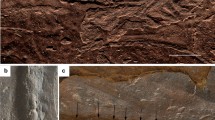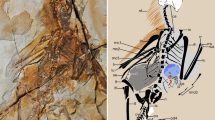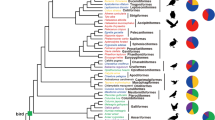Abstract
Exceptionally preserved fossils from the Palaeozoic era provide crucial insights into arthropod evolution, with recent discoveries bringing phylogeny and character homology into sharp focus1,2,3,4. Integral to such studies are anomalocaridids, a clade of stem arthropods whose remarkable morphology illuminates early arthropod relationships5,6 and Cambrian ecology7,8,9. Although recent work has focused on the anomalocaridid head6,7,8,9,10, the nature of their trunk has been debated widely5,11,12,13,14,15,16,17,18. Here we describe new anomalocaridid17 specimens from the Early Ordovician Fezouata Biota of Morocco19, which not only show well-preserved head appendages providing key ecological data, but also elucidate the nature of anomalocaridid trunk flaps, resolving their homology with arthropod trunk limbs. The new material shows that each trunk segment bears a separate dorsal and ventral pair of flaps, with a series of setal blades attached at the base of the dorsal flaps. Comparisons with other stem lineage arthropods16,20,21,22 indicate that anomalocaridid ventral flaps are homologous with lobopodous walking limbs and the endopod of the euarthropod biramous limb, whereas the dorsal flaps and associated setal blades are homologous with the flaps of gilled lobopodians (for example, Kerygmachela kierkegaardi, Pambdelurion whittingtoni) and exites of the ‘Cambrian biramous limb’23. This evidence shows that anomalocaridids represent a stage before the fusion of exite and endopod into the ‘Cambrian biramous limb’5,16,23, confirming their basal placement in the euarthropod stem4,5,6, rather than in the arthropod crown24 or with cycloneuralian worms14. Unlike other anomalocaridids, the Fezouata taxon combines head appendages convergently9 adapted for filter-feeding with an unprecedented body length exceeding 2 m, indicating a new direction in the feeding ecology of the clade. The evolution of giant filter-feeding anomalocaridids may reflect the establishment of highly developed planktic ecosystems during the Great Ordovician Biodiversification Event25.
This is a preview of subscription content, access via your institution
Access options
Subscribe to this journal
Receive 51 print issues and online access
$199.00 per year
only $3.90 per issue
Buy this article
- Purchase on Springer Link
- Instant access to full article PDF
Prices may be subject to local taxes which are calculated during checkout




Similar content being viewed by others
References
Ma, X., Hou, X., Edgecombe, G. D. & Strausfeld, N. J. Complex brains and optic lobes in an early Cambrian arthropod. Nature 490, 258–261 (2012)
Yang, J., Ortega-Hernández, J., Butterfield, N. J. & Zhang, Z. Specialized appendages in fuxianhuiids and the head organization of early euarthropods. Nature 494, 468–471 (2013)
Tanaka, G., Hou, X., Ma, X., Edgecombe, G. D. & Strausfeld, N. J. Chelicerate neural ground pattern in a Cambrian great appendage arthropod. Nature 502, 364–367 (2013)
Budd, G. E. A palaeontological solution to the arthropod head problem. Nature 417, 271–275 (2002)
Daley, A. C., Budd, G. E., Caron, J.-B., Edgecombe, G. D. & Collins, D. The Burgess Shale anomalocaridid Hurdia and its significance for early euarthropod evolution. Science 323, 1597–1600 (2009)
Cong, P., Ma, X., Hou, X., Edgecombe, G. D. & Strausfeld, N. J. Brain structure resolves the segmental affinity of anomalocaridid appendages. Nature 513, 538–542 (2014)
Daley, A. C. & Budd, G. E. New anomalocaridid appendages from the Burgess Shale, Canada. Palaeontology 53, 721–738 (2010)
Paterson, J. R. et al. Acute vision in the giant Cambrian predator Anomalocaris and the origin of compound eyes. Nature 480, 237–240 (2011)
Vinther, J., Stein, M., Longrich, N. R. & Harper, D. A. T. A suspension-feeding anomalocarid from the Early Cambrian. Nature 507, 496–499 (2014)
Daley, A. C. & Bergström, J. The oral cone of Anomalocaris is not a classic “peytoia”. Naturwissenschaften 99, 501–504 (2012)
Whittington, H. B. & Briggs, D. E. G. The largest Cambrian animal, Anomalocaris, Burgess Shale, British Columbia. Phil. Trans. R. Soc. Lond. B. 309, 569–609 (1985)
Bergström, J. Opabinia and Anomalocaris, unique Cambrian ‘arthropods’. Lethaia 19, 241–246 (1986)
Chen, J., Ramsköld, L. & Zhou, G. Evidence for monophyly and arthropod affinity of Cambrian giant predators. Science 264, 1304–1308 (1994)
Hou, X., Bergström, J. & Ahlberg, P. Anomalocaris and other large animals in the Lower Cambrian Chengjiang Fauna of southwest China. GFF 117, 163–183 (1995)
Collins, D. The “evolution” of Anomalocaris and its classification in the arthropod class Dinocarida (nov) and order Radiodonta (nov). J. Paleontol. 70, 280–293 (1996)
Budd, G. E. The morphology of Opabinia regalis and the reconstruction of the arthropod stem-group. Lethaia 29, 1–14 (1996)
Van Roy, P. & Briggs, D. E. G. A giant Ordovician anomalocaridid. Nature 473, 510–513 (2011)
Daley, A. C. & Edgecombe, G. D. Morphology of Anomalocaris canadensis from the Burgess Shale. J. Paleontol. 88, 68–91 (2013)
Van Roy, P. et al. Ordovician faunas of Burgess Shale type. Nature 465, 215–218 (2010)
Budd, G. E. A Cambrian gilled lobopod from Greenland. Nature 364, 709–711 (1993)
Budd, G. E. The morphology and phylogenetic significance of Kerygmachela kierkegaardi Budd (Buen Formation, Lower Cambrian, N Greenland). Trans. R. Soc. Edinb. Earth Sci. 89, 249–290 (1999)
Budd, G. E. & Daley, A. C. The lobes and lobopods of Opabinia regalis from the middle Cambrian Burgess Shale. Lethaia 45, 83–95 (2012)
Wolff, C. & Scholtz, G. The clonal composition of biramous and uniramous arthropod limbs. Proc. R. Soc. B 275, 1023–1028 (2008)
Haug, J. T., Waloszek, D., Maas, A., Liu, Y. & Haug, C. Functional morphology, ontogeny and evolution of mantis shrimp-like predators in the Cambrian. Palaeontology 55, 369–399 (2012)
Servais, T., Owen, A. W., Harper, D. A. T., Kröger, B. & Munnecke, A. The Great Ordovician Biodiversification Event (GOBE): the palaeoecological dimension. Palaeogeogr. Palaeoclimatol. Palaeoecol. 294, 99–119 (2010)
Zhang, X. & Briggs, D. E. G. The nature and significance of the appendages of Opabinia from the Middle Cambrian Burgess Shale. Lethaia 40, 161–173 (2007)
Braddy, S. J., Poschmann, M. & Tetlie, O. E. Giant claw reveals the largest ever arthropod. Biol. Lett. 4, 106–109 (2008)
Schneider, J. & Werneburg, R. Arthropleura und Diplopoda (Arthropoda) aus dem Unter-Rotliegend (Unter-Perm, Assel) des Thüringer Waldes (Südwest-Saale-Senke). Veröff. Naturhist. Mus. Schleusingen 13, 19–36 (1998)
Friedman, M. et al. 100-million-year dynasty of giant planktivorous bony fishes in the Mesozoic seas. Science 327, 990–993 (2010)
Marx, F. G. & Uhen, M. D. Climate, critters, and cetaceans: Cenozoic drivers of the evolution of modern whales. Science 327, 993–996 (2010)
Acknowledgements
M. and B. ‘Ou Said’ Ben Moula discovered the specimens and provided support in the field. S. Beardmore, D. Field, A. Little, R. Racicot and O. E. Tetlie assisted with fieldwork in 2011. L. Ben Moula and B. Tahiri provided practical assistance. J.-B. Caron loaned specimens of Hurdia from ROM collections. S. Butts and J. Utrup, K. Hollis and D. Erwin curated specimens and facilitated access to the collections at the YPM and USNM respectively. N. Utrup built custom cradles to support the articulated specimens. J. Vinther and P. Hull discussed filter-feeding and gigantism, and J. Lamsdell eurypterid book gills and phylogenetic methodology. E. Martin made available precise biostratigraphical data for the localities. G. Edgecombe provided unpublished observations on Cucumericrus. M. Collins discussed appendage function and prepared the digital reconstruction (Fig. 3). M. Fox advised on preparation and consolidation techniques and provided equipment. C. Graham and J. Slawski provided support and access to digital imaging facilities. The initial part of the research was done while P.V.R. was at Ghent University and in receipt of a mobility grant from the Biology Commission of the Research Foundation – Flanders (FWO). A.C.D. was financially supported by the Swedish Research Council (Vetenskapsrådet) and the Oxford University Museum of Natural History. The research was supported by National Science Foundation Grant EAR-1053247 and by the Division of Invertebrate Paleontology, YPM.
Author information
Authors and Affiliations
Contributions
All authors, led by P.V.R., participated in the interpretation of the material and reconstruction of A. benmoulae and contributed to writing and editing the manuscript. P.V.R. and A.C.D. examined the material of P. nathorsti at the USNM and conducted the phylogenetic analyses. P.V.R. conducted fieldwork in Morocco, prepared and photographed Fezouata specimens, made preliminary reconstructions and composed the figures. A.C.D. photographed Burgess Shale specimens, prepared all explanatory specimen drawings and made the Burgess Shale figure.
Corresponding author
Ethics declarations
Competing interests
The authors declare no competing financial interests.
Extended data figures and tables
Extended Data Figure 1 A. benmoulae, nearly complete three-dimensionally preserved specimen, counterpart, dorsal view, Early Ordovician, Fezouata Biota, Morocco, holotype YPM 237172.
a, With separate blocks in place, showing ventral flaps. b, With one block removed, showing dorsal flaps. c, With two blocks removed, showing dorsal flaps alone. d, Digital combination of images, showing both dorsal and ventral flaps. e, Interpretative drawing of dorsal view combining information from part and counterpart. Arabic numerals indicate trunk somites.
Extended Data Figure 2 A. benmoulae, nearly complete three-dimensionally preserved specimen, dorsal and ventral flaps, Early Ordovician, Fezouata Biota, Morocco, holotype YPM 237172.
a, Separate block, part, dorsal flaps, plan view. b, Separate block, lateral view showing body wall (counterpart), and dorsal (part) and ventral flaps (counterpart). c, Separate block, counterpart, ventral flaps. d, Counterpart, dorsal flaps. e, Interpretative drawing of lateral view of separate block. f, part, ventral flaps. g, Part, muscle tissue closely associated with first dorsal flap on left side, showing individual fibres.
Extended Data Figure 3 A. benmoulae, central elements of carapace, Early Ordovician, Fezouata Biota, Morocco.
a, b, YPM 516785: a, nearly complete central element, part, dorsal view; b, interpretative drawing. c, d, Paratype YPM 227556: c, nearly complete central element, part, dorsal view; d, interpretative drawing. e, f, YPM 523425: e, ventral triangular extension, counterpart, showing marginal rim and texture; f, interpretative drawing. g, h, YPM 523424: g, partial central element, part, oblique, showing second morph with additional anterior triangular extension; h, interpretative drawing.
Extended Data Figure 4 A. benmoulae, complete carapace lateral element associated with partial central element, Early Ordovician, Fezouata Biota, Morocco, paratype YPM 525437.
a, With partial central element, part, in place. b, With partial central element, part, removed, revealing counterpart imprint of triangular ventral extension. c, With dorsal side of central element digitally removed, revealing triangular ventral extension overlying anterior of lateral element. d, Interpretative drawing.
Extended Data Figure 5 A. benmoulae, appendages and ventral spines, Early Ordovician, Fezouata Biota, Morocco.
a–c, Paratype YPM 527123, nearly complete appendage: a, part; b, interpretative drawing combining part and counterpart; c, counterpart. d, YPM 527124, part, distal portion of ventral spines. Setae showing double row of spinules arrowed. YPM 527123 and 527124 belong to a disarticulated assemblage which may represent a single individual. e, YPM 523810, part, distal portion of five ventral spines. f, YPM 523423 and 523424, counterpart, ventral spines and partial carapace element. g, YPM 523428, part, termination of ventral spine. Roman numerals indicate appendage podomeres.
Extended Data Figure 6 A. benmoulae, appendages and appendage ventral spines, Early Ordovician, Fezouata Biota, Morocco.
a, Close-up of ventral spines of YPM 527125, showing spinulose filtrating setae and their insertion on the anterior margin of the ventral spines. Setae showing double row of spinules arrowed. b–d, YPM 525217, partial appendage: b, part; c, interpretative drawing combining information from part and counterpart; d, counterpart. Roman numerals indicate appendage podomeres.
Extended Data Figure 7 A. benmoulae, Early Ordovician, Fezouata Biota, Morocco.
a–c, Partial appendage, paratype YPM 522227: a, part; b, interpretative drawing combining information from part and counterpart; c, counterpart. Roman numerals indicate appendage podomeres. d, e, Assemblage of carapace elements, appendage ventral spines and setal blades, YPM 523423–523427: d, specimen; e, interpretative drawing.
Extended Data Figure 8 A. benmoulae, isolated bands of setal blades, Early Ordovician, Fezouata Biota, Morocco.
a–c, YPM 516791: a, part; b, counterpart; c, close-up of counterpart, showing fine lateral lamellae on setal blades in plan view. d, Specimen associated with YPM 527123, part, showing lamellae on setal blades. e, YPM 227934, part, showing connection between setal blades and division into short anterior and long posterior free parts. f, YPM 516792, part.
Extended Data Figure 9 P. nathorsti, articulated specimens showing dorsal flaps, middle Cambrian, Burgess Shale, Canada.
a, USNM 274156 and USNM 274161 joined into complete specimen. White box indicates area of close-ups of USNM 274161 in b and c. b, c, USNM 274161: b, posterior, counterpart, showing two sets of flaps; c, interpretative drawing. d, USNM 274154, the opposite half of the split corresponding to USNM 274156 and 274161. e, USNM 274145. Blue arrows indicate ventral flaps; orange arrows indicate dorsal flaps.
Extended Data Figure 10 Results of the phylogenetic analysis.
Strict consensus of 70 most parsimonious trees obtained under equal weighting (consistency index = 0.611; retention index = 0.798). Numbers above nodes indicate Bremer support/standard bootstrap (1,000 replicates) values; number below nodes is the jackknife (1,000 replicates, P = 36) value. An identical strict consensus tree is obtained with implied weighting for all k values from 3 to 8.
Supplementary information
Supplementary Information
This file contains additional detailed description and interpretation; discussion of functional morphology, mode of life, presence of dorsal flaps and trunk limbs in other anomalocaridids, and phylogenetic position; comparison with other taxa; a list of previously figured Aegirocassis benmoulae specimens and Supplementary References. (PDF 577 kb)
Supplementary Data
This file contains the phylogenetic matrix used for the phylogenetic analysis, including the data matrix. (TXT 12 kb)
Video clarifying the position of the separate block and the relationship of dorsal and ventral flaps in the complete holotype YPM 237172, and the relationship between the lateral and central carapace elements in paratype YPM 525437.
This video clarifies the position of the separate block and the relationship of dorsal and ventral flaps in the complete holotype YPM 237172, and the relationship between the lateral and central carapace elements in paratype YPM 525437. (MOV 29804 kb)
Rights and permissions
About this article
Cite this article
Van Roy, P., Daley, A. & Briggs, D. Anomalocaridid trunk limb homology revealed by a giant filter-feeder with paired flaps. Nature 522, 77–80 (2015). https://doi.org/10.1038/nature14256
Received:
Accepted:
Published:
Issue Date:
DOI: https://doi.org/10.1038/nature14256
This article is cited by
-
Rhabdopleurid epibionts from the Ordovician Fezouata Shale biota and the longevity of cross-phylum interactions
Communications Biology (2023)
-
A Middle Ordovician Burgess Shale-type fauna from Castle Bank, Wales (UK)
Nature Ecology & Evolution (2023)
-
Ordovician opabiniid-like animals and the role of the proboscis in euarthropod head evolution
Nature Communications (2022)
-
New fossil assemblages from the Early Ordovician Fezouata Biota
Scientific Reports (2022)
-
Ordovician-Cambrian Palaeontological Heritage of Zagora Province: A Bibliometric Analysis from 1984 to 2020 (Anti-Atlas, Morocco)
Geoheritage (2022)
Comments
By submitting a comment you agree to abide by our Terms and Community Guidelines. If you find something abusive or that does not comply with our terms or guidelines please flag it as inappropriate.



